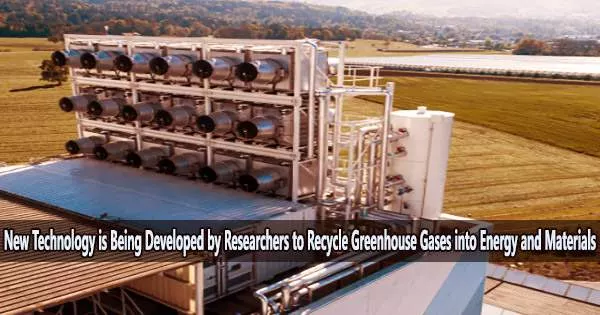Researchers at the University of Central Florida have created new techniques for converting the dangerous greenhouse gas methane into energy and materials.
According to the U.S. Environmental Protection Agency, methane has a 28 times bigger comparative influence on the Earth’s climate during a 100-year period than carbon dioxide, another significant greenhouse gas.
This is due to the fact that methane, despite having a shorter atmospheric lifespan than carbon dioxide, is more effective at trapping radiations.
Major sources of methane emissions include energy and industry, agriculture and landfills.
Methane may now be used to provide green energy and to make high-performance materials for solar cells, biotechnology, smart devices, and other applications.
The inventions come from nanotechnologist Laurene Tetard and catalysis expert Richard Blair, who have been research collaborators at UCF for the past 10 years.
Tetard is an associate professor and associate chair of UCF’s Department of Physics and a researcher with the NanoScience Technology Center, and Blair is a research professor at UCF’s Florida Space Institute.
A better, cleaner technology for producing hydrogen
The first invention is a method to produce hydrogen from hydrocarbons, such as methane, without releasing carbon gas.
The development demonstrates a novel functionality of nanoscale materials for visible light-assisted capture and the conversion of hydrocarbons like methane. Visible light can be produced by a laser, lamp, or solar source, and is used in conjunction with defect-engineered boron-rich photocatalysts. Defect engineering refers to creating irregularly structured materials.
With typical catalysts, reactions carried out at higher temperatures frequently result in pollutants like higher polyaromatic compounds, carbon dioxide, or carbon monoxide, but the UCF discovery creates hydrogen devoid of these impurities.
We started seeing some lines, but it’s a loose, messy powder, so it shouldn’t be ordered. But when we zoomed in some more, we saw some carbon and lots of it, with the defect-engineered boron-nitride powder clinging to the top of it.
Laurene Tetard
The advancement may result in cheaper prices for energy-producing catalysts, increased photocatalytic conversion in the visible range, and more effective use of solar energy for catalysis.
Market applications include possible large-scale production of hydrogen in solar farms and the capture and conversion of methane.
“That invention is actually a twofer,” Blair says. “You get green hydrogen, and you remove not really sequester methane. You’re processing methane into just hydrogen and pure carbon that can be used for things like batteries.”
He says traditional hydrogen production uses high temperatures with methane and water, but in addition to hydrogen, that process also generates carbon dioxide.
“Our process takes a greenhouse gas, methane and converts it into something that’s not a greenhouse gas and two things that are valuable products, hydrogen and carbon,” Blair says. “And we’ve removed methane from the cycle.”
He noted that at UCF’s Exolith Lab they were able to generate hydrogen from methane gas using sunlight by putting the system on a large solar concentrator.
Knowing this, he says countries that don’t have abundant sources of power could use the invention since all they would need is methane and sunlight.
Besides oil and natural gas systems, methane exists in landfills, industrial and agricultural areas, and wastewater treatment sites.
Growing contaminant-free carbon nano/microstructures
This technology developed by Tetard and Blair is a method for producing carbon nanoscale and microscale structures with controlled dimensions. It converts various carbon sources into structured, well-defined nanoscale and microscale structures using light and a photocatalyst with a flaw. Examples include methane, ethane, propane, propene and carbon monoxide.
“It’s like having a carbon 3D printer instead of a polymer 3D printer,” Tetard says. “If we have a tool like this, then maybe there are even some carbon scaffolding designs we can come up with that are impossible today.”
Blair says the dream is to make high-performance carbon materials from methane, which is currently not done very well right now, he says.
“So, this invention would be a way to make such materials from methane in a sustainable manner on a large industrial scale,” Blair says.
The resulting carbon structures may be constructed exactly, with precise sizes and patterns, and are small but well-structured.
“Now you’re talking high-dollar applications, perhaps for medical devices or new chemical sensors,” Blair says. “This becomes a platform for developing all sorts of products. The application is only limited by the imagination.”
The growing process is adjustable at different wavelengths, therefore different lasers or sun light could be used in the design process.
Tetard’s lab, which works at the nanoscale, is now trying to reduce the size.
“We’re trying to think of a way to learn from the process and see how we could make it work at even the smaller scales control the light in a tiny volume,” she says.
“Right now, the size of the structures is microscale because the light focal volume we create is microsize,” she says. “So, if we can control the light in a tiny volume, maybe we can grow nano-sized objects for patterned nanostructures a thousand times smaller. That’s something we’re thinking of implementing in the future. And then, if that becomes possible, there are many things we can do with that.”
A better, cleaner technology for producing carbon
In fact, the researchers’ earlier, ground-breaking technique for creating carbon from defect-engineered boron-nitride with visible light served as the inspiration for their better, cleaner technology for making hydrogen.
By chemically breaking hydrocarbons using energy from visible light coupled with a metal-free catalyst, defect-engineered boron-nitride, they identified a novel method to create carbon and hydrogen.
It is superior than other procedures since it doesn’t need as much time, energy, specialized chemicals, or precursors that leave contaminants.
All that’s left is carbon and some traces of boron and nitrogen, none of which are toxic to humans or the environment.
Numerous uses for the photochemical transformation technology are possible, such as the development of sensors or new nanoelectronic parts, energy storage, quantum devices, and sustainable hydrogen production.
Strong collaboration
As longtime research collaborators Tetard and Blair are all too familiar with the old saying, “If at first you don’t succeed, try, try again.”
“It took a while to get some really exciting results,” Tetard says. “In the beginning, a lot of the characterization that we tried to do was not working the way we wanted. We sat down to discuss puzzling observations so many times.”
Yet, they plowed forward, and their perseverance paid off with their new inventions.
“Richard has a million different ideas on how to fix problems,” Tetard says. “So eventually, we would find something that works.”
She and Blair joined forces shortly after meeting in 2013 at UCF’s physics department. Blair sought to share the knowledge and further his research after finding “unheard-of” catalytic characteristics in the chemical molecule boron nitride.
He had a collaborator for theoretical modeling, Talat Rahman, a distinguished Pegasus Professor in the Department of Physics, but he needed someone to help characterize the findings.
“At the characterization level, that’s not where my strength is,” he says. “I have strengths that complement Laurene’s strengths. It made sense to see if we could do something together and if she could add some insight to what we were seeing.”
So, in collaboration with Rahman and the U.S. National Science Foundation, they hoped to gain a molecular understanding of the catalytic properties defect-laden, hexagonal (crystal structured) boron nitride, a metal-free catalyst.
Typical catalysts often consist of metals, and boron nitride, sometimes called “white graphite,” has had many industrial uses due to its slippery properties, but not for catalysis.
“Until we came along, that kind of boron nitride was considered just inert,” Blair says. “Maybe a lubricant, maybe for cosmetics. But it didn’t have any chemical use. However, with defect engineering, the research team found that the compound had great potential for producing carbon and green hydrogen, possibly in large volumes.”
The technology the team developed for making carbon from defect-engineered boron-nitride using visible light came unexpectedly.
Blair says that to analyze the catalyst’s surface, they would place it in a small container, pressurize it with a hydrocarbon gas, such as propene, and then expose it to laser light.
“Each time, it did two things that were frustrating,” he says. “The catalyst itself emitted light that obscured any data we needed, and the student kept saying, ‘it’s getting burned’ and I would say that’s impossible. There’s no carbon on the catalyst.”
“And there was no oxygen,” adds Tetard. They were stumped.
“If we wanted to study that burning spot, it needed to be bigger,” she says.
Once they managed to produce a larger sample, they put it under the electron microscope.
“We started seeing some lines, but it’s a loose, messy powder, so it shouldn’t be ordered,” Tetard said. “But when we zoomed in some more, we saw some carbon and lots of it, with the defect-engineered boron-nitride powder clinging to the top of it.”
The discovery would enable hydrogen synthesis at low temperatures and the generation of carbon as a byproduct with no emission of greenhouse gases or pollutants, which was initially perceived as a problem but was really serendipitous.
















